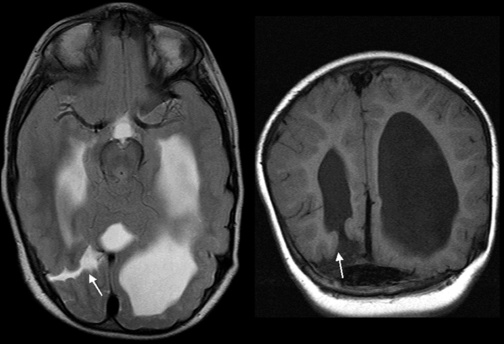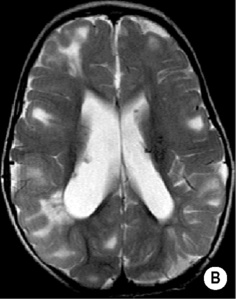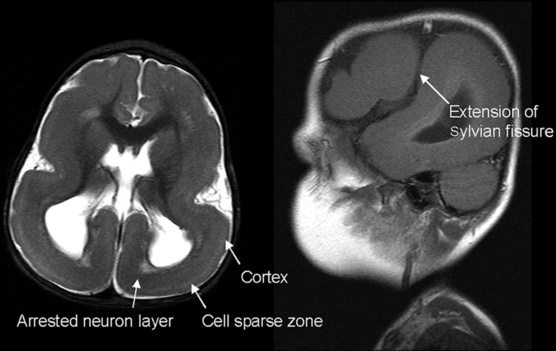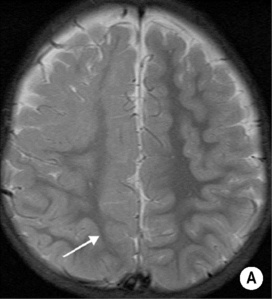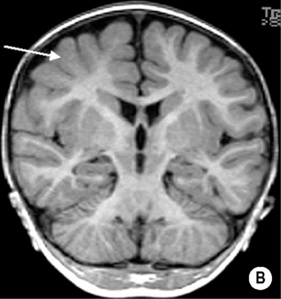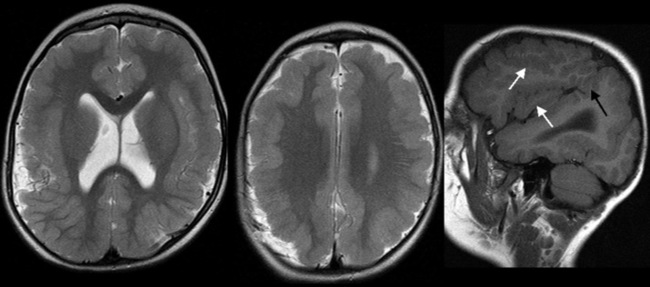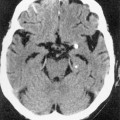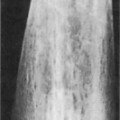• This encompasses a spectrum of cystic posterior fossa malformations from the complete Dandy–Walker malformation to a mega cisterna magna • It is associated with hydrocephalus and other midline abnormalities (e.g. agenesis or a lipoma of the corpus callosum) • Total aplasia of the cerebellar vermis reflecting the failure of formation of the decussation of the superior cerebellar peduncles, a lack of the pyramidal decussations, and other anomalies of the midbrain crossing tracts and their nuclei • Occasionally a genetic locus has been identified • Many syndromes with additional features (e.g. renal cysts, ocular abnormalities, liver fibrosis, hypothalamic hamartomas and polymicrogyria) have been classified with this anomaly • A developmental mass lesion with enlargement of the cerebellar cortex A non-enhancing mass with diffusely enlarged cerebellar folia (± pial enhancement) • A form of hindbrain deformation rather than a true malformation characterized by tonsillar descent • It is often an isolated hindbrain abnormality of little consequence • There are usually no symptoms during childhood unless there is an associated syringomyelia or hydrocephalus • Clinical symptoms are more likely when there is > 5mm of descent below the foramen magnum (children between 5 and 15 years can have normal tonsillar descent of up to 6mm) • Symptoms may include a cough-induced headache, cranial nerve palsies and a disassociated peripheral anaesthesia • A congenital malformation of the hindbrain (with a dysplastic cerebellum) that is almost always associated with a myelomeningocele • The inferior vermis is everted (rather than inverted) so that the nodulus becomes its most inferior aspect and the 4th ventricle is reduced to a coronal cleft (the cerebellar herniation consists mainly of the cerebellar vermis) • ‘Tectal beaking’: this follows fusion of the midbrain colliculi into a single beak pointing posteriorly • ‘Towering cerebellum’: the tentorial incisura is enlarged and the cerebellum herniates superiorly into the supratentorial space • ‘Batwing’ configuration of the frontal horns (coronal view): this is due to impressions from prominent caudate nuclei • ‘Hourglass ventricle’: a small biconcave 3rd ventricle due to a large massa intermedia • ‘Cervicomedullary kink’: herniation of the medulla posterior to the spinal cord • ‘Banana’ sign: the cerebellum is wrapped around the posterior brainstem (seen during obstetric US) • These are malformations related to the formation of the neural tube (also including Chiari II malformations) • An extracranial protrusion of intracranial structures through a congenital defect of the skull and dura mater • Meningocele: containing leptomeninges and CSF only • Encephalocele: containing leptomeninges, CSF and neural tissue • Encephalocystocele: containing leptomeninges, CSF, neural tissue and part of the ventricle • A midline malformation of ventral induction of the anterior brain, skull and face (resulting from the failure of the embryonic prosencephalon to undergo segmentation and cleavage into two separate cerebral hemispheres) • The anterior part (the posterior genu and anterior body) of the corpus callosum is formed before the posterior part (the posterior body and splenium) • This is located parallel to the ventricular wall and is seen as a homogeneous band of grey matter between the lateral ventricle and the cerebral cortex (separated from both by a layer of white matter) • It is commonly seen in girls with variable developmental delay or seizures
Paediatric neuroradiology
CEREBELLAR MALFORMATIONS
CEREBELLAR HYPOPLASIA
DEFINITION
DANDY–WALKER COMPLEX
DEFINITION
 Membranous obstruction to the foramina of Magendie and Luschka causes cystic dilatation of the 4th ventricle
Membranous obstruction to the foramina of Magendie and Luschka causes cystic dilatation of the 4th ventricle
 All have an apparently focal extra-axial CSF collection which is continuous with the 4th ventricle (with a variable degree of cerebellar hypoplasia)
All have an apparently focal extra-axial CSF collection which is continuous with the 4th ventricle (with a variable degree of cerebellar hypoplasia)
JOUBERT’S SYNDROME
DEFINITION
OTHER CEREBELLAR MALFORMATIONS
Lhermitte–Duclos or dysplastic cerebellar gangliocytoma
 this usually affects one hemisphere
this usually affects one hemisphere
MRI
Dandy–Walker malformation
Dandy–Walker variant
Mega cisterna magna
Posterior fossa
Enlarged
Normal
Normal or enlarged
Vermis
Absent or very hypoplastic
Hypoplastic
Normal
Hypoplastic cerebellar hemisphere
Yes
Rare
No
Hydrocephalus
75%
25%
Unusual
Supratentorial abnormalities
Common
Uncommon
Rare
Falx cerebelli
Absent
Present (32%)
Present (63%)
4th ventricle
Opens into cyst
Cyst dilatation
Normal
Prognosis
Poor
Good
Good
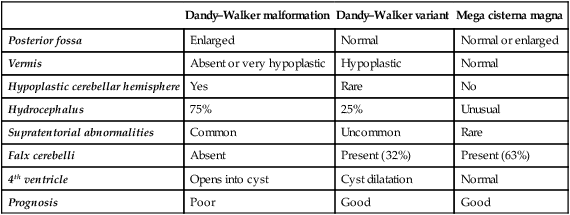
CHIARI MALFORMATIONS
CHIARI I MALFORMATION (CEREBELLAR ECTOPIA)
Definition
 it may be an acquired condition due to raised intracranial pressures, lowered intraspinal pressures or diminished posterior fossa volumes (e.g. basilar invagination)
it may be an acquired condition due to raised intracranial pressures, lowered intraspinal pressures or diminished posterior fossa volumes (e.g. basilar invagination)
Clinical presentation
CHIARI II MALFORMATION
Definition
 the medulla is invariably elongated and kinked
the medulla is invariably elongated and kinked
Radiological features
CEREBRAL MALFORMATIONS
DISORDERS OF DORSAL INDUCTION
DEFINITION
Cephalocele
 unlike a spinal myelomeningocele there is usually no skin defect
unlike a spinal myelomeningocele there is usually no skin defect  they tend to occur in the occipital and frontal regions and may be pulsatile
they tend to occur in the occipital and frontal regions and may be pulsatile
DISORDERS OF VENTRAL INDUCTION
DEFINITION
Holoprosencephaly
 it is associated with chromosomal abnormalities, facial clefting and various teratogenic factors (including maternal diabetes)
it is associated with chromosomal abnormalities, facial clefting and various teratogenic factors (including maternal diabetes)
MALFORMATIONS OF COMMISSURAL AND RELATED STRUCTURES
DEFINITION
PEARL
 thus a small or absent genu or body, with an intact splenium and rostrum, indicates secondary destruction rather than abnormal development
thus a small or absent genu or body, with an intact splenium and rostrum, indicates secondary destruction rather than abnormal development
Alobar form
Severe form (often fatal)
Semilobar form
Intermediate form
Lobar form
Mild form
Cleavage into two hemispheres
None (a ‘cup’-shaped brain)
Partial posterior cleaving
Complete
Facial abnormalities (e.g. cyclopia1 and hypotelorism2)
Severe
Intermediate
None
Lateral ventricles
U-shaped monoventricle with a dorsal cyst
Partial anterior fusion (with partial occipital and temporal horns)
Normal (the frontal horns may be ‘squared’)
Falx and corpus callosum
Absent
Absent anteriorly
Normal (they may be incomplete or dysplastic)
Thalami
Fused
Partial separation
Normal
Septum pellucidum
Absent
Absent
Absent

MALFORMATIONS OF NEURONAL MIGRATION AND CORTICAL ORGANIZATION
SCHIZENCEPHALY
GREY MATTER HETEROTOPIAS
Band heterotopia or ‘double cortex’
 the overlying cortex is usually of normal thickness but has shallow sulci
the overlying cortex is usually of normal thickness but has shallow sulci  partial heterotopias predominantly affect the frontal lobes
partial heterotopias predominantly affect the frontal lobes
Radiology Key
Fastest Radiology Insight Engine


 inborn errors of metabolism (e.g. glycolysation disorder)
inborn errors of metabolism (e.g. glycolysation disorder)
 infantile neuroaxonal dystrophy
infantile neuroaxonal dystrophy  pontocerebellar hypoplasia
pontocerebellar hypoplasia  spinocerebellar atrophies
spinocerebellar atrophies  Friedreich’s ataxia
Friedreich’s ataxia a normal-sized posterior fossa
a normal-sized posterior fossa seizures
seizures  hydrocephalus
hydrocephalus the cerebellar vermis is hypoplastic as well as rotated or aplastic
the cerebellar vermis is hypoplastic as well as rotated or aplastic  the tentorium and venous confluence of the torcula are elevated
the tentorium and venous confluence of the torcula are elevated the cerebellum and 4th ventricle are normal
the cerebellum and 4th ventricle are normal abnormal eye movements
abnormal eye movements  ataxia
ataxia the midbrain is small
the midbrain is small  the superior peduncles appear enlarged
the superior peduncles appear enlarged it is associated with other midline supratentorial anomalies (e.g. absence of the septum pellucidum and corpus callosum, as well as holoprosencephaly)
it is associated with other midline supratentorial anomalies (e.g. absence of the septum pellucidum and corpus callosum, as well as holoprosencephaly)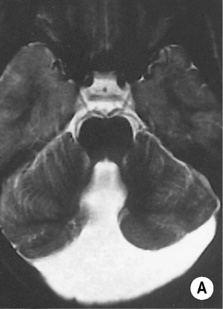
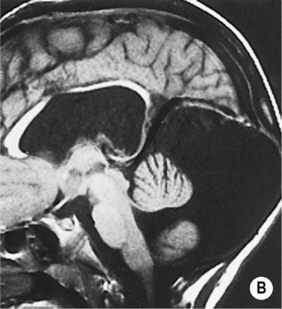

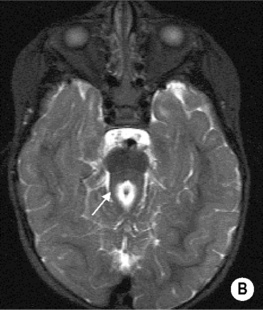
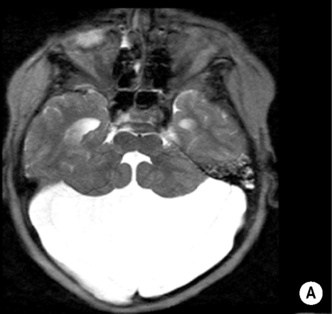
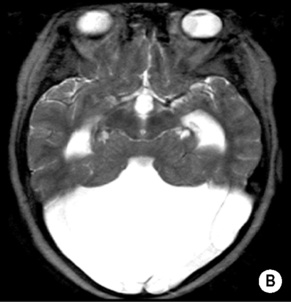
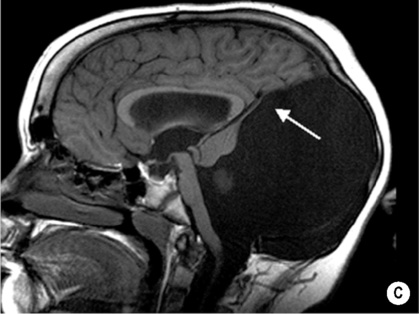
 an elongated medulla oblongata can be seen with a kink sometimes forming on its posterior surface
an elongated medulla oblongata can be seen with a kink sometimes forming on its posterior surface basilar invagination (30%)
basilar invagination (30%)  hydrocephalus (25%)
hydrocephalus (25%)  Klippel–Feil anomaly (10%)
Klippel–Feil anomaly (10%) feeding problems
feeding problems  dysphagia
dysphagia a small 4th ventricle (which is inferiorly displaced and elongated) and a small posterior fossa
a small 4th ventricle (which is inferiorly displaced and elongated) and a small posterior fossa  scalloping of the clivus
scalloping of the clivus  flattening of the ventral pons and a low attachment of the tentorium
flattening of the ventral pons and a low attachment of the tentorium  the falx is partially absent or fenestrated with consequent interdigitation of the gyri across the midline
the falx is partially absent or fenestrated with consequent interdigitation of the gyri across the midline  the foramen magnum is enlarged and ‘shield-shaped’
the foramen magnum is enlarged and ‘shield-shaped’ disorders of neuronal migration
disorders of neuronal migration  malformation of the corpus callosum
malformation of the corpus callosum  a dorsal midline cyst
a dorsal midline cyst  absence of the septum pellucidum
absence of the septum pellucidum  colpocephaly (occipital horn enlargement)
colpocephaly (occipital horn enlargement) an isolated 4th ventricle
an isolated 4th ventricle  hydro-syringomyelia
hydro-syringomyelia  compression of the craniocervical junction
compression of the craniocervical junction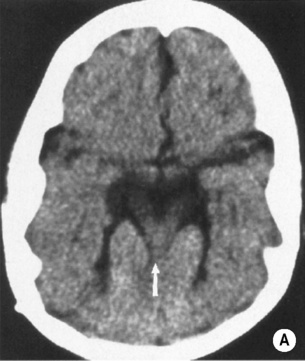
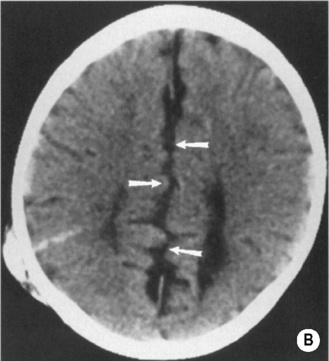
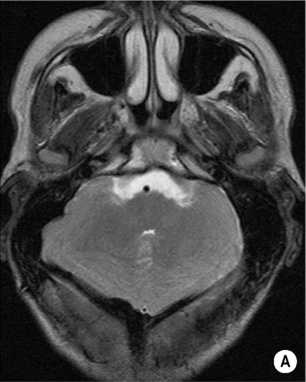
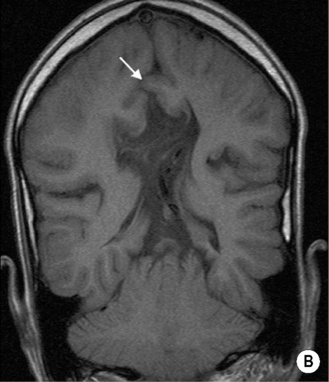
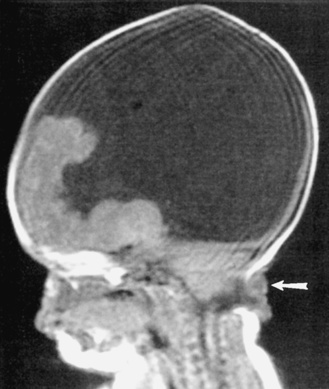

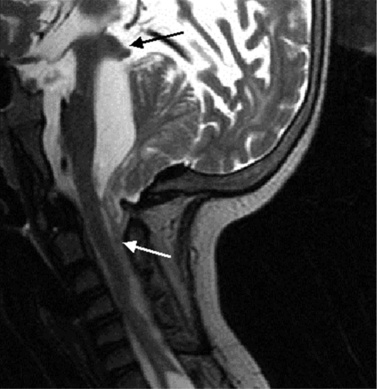
 there is no cerebral cortex present (unlike gross hydrocephalus)
there is no cerebral cortex present (unlike gross hydrocephalus) other intracranial malformations or hydrocephalus
other intracranial malformations or hydrocephalus  whether there is any ischaemia within the herniated neural tissue
whether there is any ischaemia within the herniated neural tissue Dandy–Walker malformation
Dandy–Walker malformation  interhemispheric lipoma
interhemispheric lipoma  abnormalities of neuronal migration and organization
abnormalities of neuronal migration and organization  dysraphic anomalies
dysraphic anomalies  encephaloceles
encephaloceles  septo-optic dysplasia
septo-optic dysplasia  ocular anomalies
ocular anomalies  midline facial anomalies
midline facial anomalies vertically oriented sulci extend right down to the ventricle with no horizontally running cingulate sulcus
vertically oriented sulci extend right down to the ventricle with no horizontally running cingulate sulcus  small frontal horns (‘bull’s horn’ appearance) with colpocephaly (large occipital horns)
small frontal horns (‘bull’s horn’ appearance) with colpocephaly (large occipital horns)
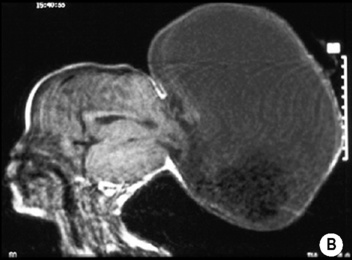
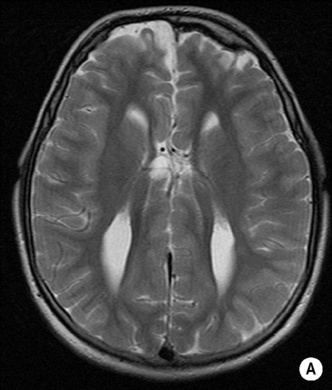
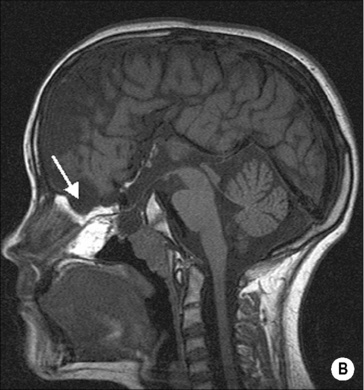
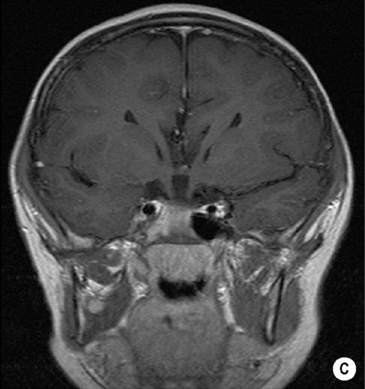
 it involves the complete cerebral mantle and connects the calvarium and the outer surface of the brain with the lateral ventricles
it involves the complete cerebral mantle and connects the calvarium and the outer surface of the brain with the lateral ventricles it is also found within the parasagittal, frontal or occipital sites (with mild clinical manifestations)
it is also found within the parasagittal, frontal or occipital sites (with mild clinical manifestations) spasticity
spasticity  severe mental and psychomotor developmental delay (with bilateral clefts)
severe mental and psychomotor developmental delay (with bilateral clefts) it is associated with subependymal heterotopias (within the contralateral hemisphere) and subependymal or parenchymal calcification
it is associated with subependymal heterotopias (within the contralateral hemisphere) and subependymal or parenchymal calcification it is associated with agenesis or hypoplasia of the corpus callosum and septum pellucidum
it is associated with agenesis or hypoplasia of the corpus callosum and septum pellucidum heterotopias are prominent and there is often a delay in myelination
heterotopias are prominent and there is often a delay in myelination  it may be seen in congenital muscular dystrophies
it may be seen in congenital muscular dystrophies T1WI + Gad: there is no enhancement
T1WI + Gad: there is no enhancement they are also more heterogeneous and may enhance
they are also more heterogeneous and may enhance it may coexist with schizencephaly, microcephaly, polymicrogyria, dysgenesis of the corpus callosum, or absence of the septum pellucidum
it may coexist with schizencephaly, microcephaly, polymicrogyria, dysgenesis of the corpus callosum, or absence of the septum pellucidum the extent varies from small, isolated, unilateral areas to larger areas of bilateral disease
the extent varies from small, isolated, unilateral areas to larger areas of bilateral disease there may calcification or abnormal venous drainage
there may calcification or abnormal venous drainage other associations include neurofibromatosis type 1 (NF-1) and tuberous sclerosis
other associations include neurofibromatosis type 1 (NF-1) and tuberous sclerosis the affected hemisphere is usually (but not always) enlarged with diffuse cortical thickening, white matter signal abnormality and possibly calcification
the affected hemisphere is usually (but not always) enlarged with diffuse cortical thickening, white matter signal abnormality and possibly calcification